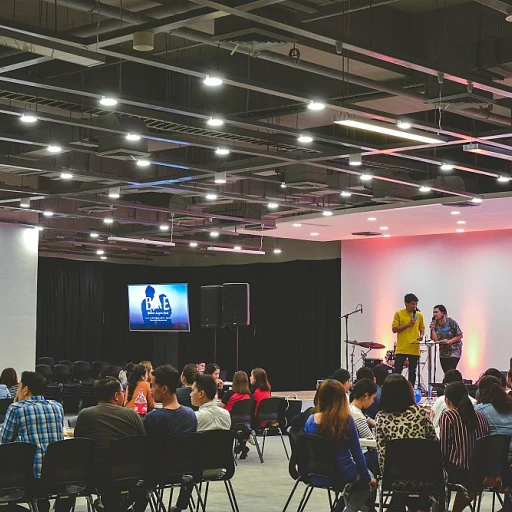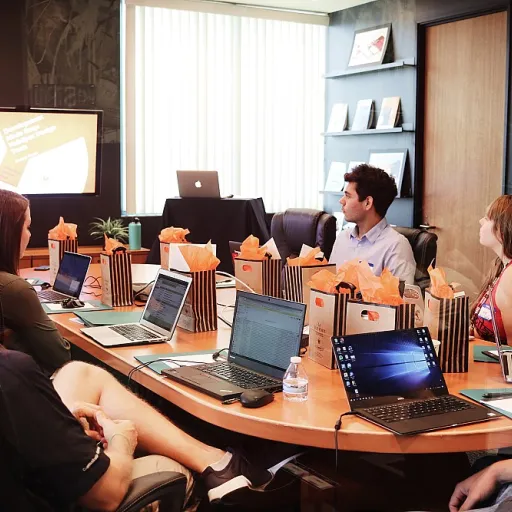
Understanding Accessible Staffing
Defining the Core of Accessible Staffing
Accessible staffing goes beyond filling job vacancies—it establishes pathways for all professionals, regardless of their physical or cognitive abilities, to obtain and maintain meaningful employment. The staffing industry, particularly in sectors like health care and medical facilities, including hospitals and certified nursing, plays a pivotal role in shaping accessible workplaces. This is acutely observed in locations such as Indianapolis, where headquarters for multiple staffing companies reside.
To provide effective staffing solutions, companies need to ensure they facilitate an inclusive environment. This means adapting their hiring processes to better support accessibility not only in traditional office settings but also in spaces where individuals may need health or care services. For instance, certified nurses working in suites may require specific accessibility accommodations.
Accessible staffing is not just a healthcare need but a holistic approach to employment that transcends all professions. By prioritizing accessibility, staffing companies deliver better support to their professionals, thereby enhancing service delivery. This commitment is reflected in the success of staffing accessible services in places such as headquarters Indianapolis, showcasing a move toward an inclusive recruitment process.
For professionals in the staffing industry aiming to enhance their recruitment capabilities, continuous improvement in recruitment skills is pivotal. Leveraging knowledge and skills through effective staffing training can lead to a more accessible staffing environment. If you're looking to develop these skills further, you may find valuable insights in enhancing your recruitment skills with effective staffing training, where key principles for accessible staffing are discussed.
Challenges in Candidate Sourcing
Identifying Barriers in Finding the Right Talent
In recent years, the challenges of candidate sourcing have become prominent in the staffing industry, especially within sectors like health care and nursing. Healthcare companies and hospitals strive to provide accessible staffing solutions, yet accessing a certified, qualified workforce remains a hurdle.Navigating the Competitive Landscape
The staffing industry has evolved into a competitive arena, with many professionals and companies vying for top talent. In sectors such as medical staffing and accessible medical solutions, the demand for skilled nurses and healthcare professionals intensifies this competition. Organizations must work diligently to attract candidates who not only meet the qualifications but also align with the company's culture, particularly in headquarters Indianapolis and other urban centers.Overcoming Resource Constraints
Resource limitations, such as budget restrictions and time constraints, are significant barriers in candidate sourcing. Companies need to balance the costs of recruiting certified medical staff, particularly in specialties requiring extensive training and experience. Time is also a premium resource when urgent staffing needs arise, and accessing immediate solutions becomes crucial.Adapting to the Evolving Workforce Needs
Healthcare and staffing industries often face challenges related to evolving workforce needs. For instance, the demand for specific care roles, such as certified nursing assistants or specialized medical practitioners, changes with industry trends. This requires staffing companies to continually adjust their sourcing strategies to match market demands and care requirements. For a detailed exploration of management strategies during transitional periods in staffing and recruiting, consider reading a comprehensive guide on understanding interim management. It provides insightful perspectives on how to navigate these complex scenarios effectively.Ensuring Compliance and Inclusivity
Compliance with industry standards and regulations introduces another layer of complexity. Staffing accessible must consider employment laws, which vary significantly between locations and sectors, such as health and care facilities. Additionally, building inclusive recruitment processes that cater to diverse applicant pools is essential for organizational growth and reputation in accessible staffing.Strategies for Effective Candidate Sourcing
Crafting Tailored Strategies for Success
In the realm of staffing, the process of candidate sourcing often requires a tailored approach to meet the unique demands of the healthcare and medical industries. Effective strategies are paramount to provide the right professionals where they are needed most, be it hospitals in Indianapolis or certified nursing services across the country. These strategies hinge on understanding both the broader staffing industry and the health care sector's nuances. One way to enhance the effectiveness of candidate sourcing is through leveraging data-driven insights. By thoroughly analyzing market trends, staffing companies can anticipate needs within hospitals, nursing homes, and other healthcare facilities. This anticipation allows them to proactively sign on a suite of qualified, certified professionals ready to step in at a moment's notice. Working in tandem with the growing role of technology in accessible staffing, integrating advanced candidate tracking systems can streamline finding and onboarding the right candidate. These systems enable recruiters to efficiently filter through vast databases, ensuring that only the most suitable candidates are considered, thus optimizing the staffing accessible process. Finally, building an inclusive recruitment process ensures that no potential caregiver is overlooked due to a lack of accessibility. Not only does this commitment align with ethical standards, but it also broadens the pool of qualified professionals. By implementing these strategies, companies can enhance the health and medical services they provide, fostering a more inclusive healthcare environment. For more information on effective candidate sourcing, visit enhancing workforce potential.The Role of Technology in Accessible Staffing
The Influence of Technology in the Staffing Landscape
In the rapidly evolving realm of staffing, technology has become an irreplaceable ally, significantly facilitating accessible staffing initiatives. From automating cumbersome tasks to refining candidate sourcing, technology offers immense potential to transform every aspect of health and medical staffing.- Streamlined Hiring Process: With an ever-increasing talent pool in healthcare professions such as nursing and certified medical care, staffing technology can streamline the process. Hospitals and healthcare companies in cities like Indianapolis can leverage software to quickly assess and process candidate credentials, enabling a more efficient hiring workflow.
- Enhanced Reach and Access: Technology empowers staffing companies to tap into a broader audience, making healthcare positions more accessible to professionals seeking employment. Whether reaching certified nurses or specialized medical professionals, platforms and tools can serve as conduits, providing access to opportunities irrespective of geographical limitations.
- Data-Driven Insights: Utilizing analytics can revolutionize staffing strategies by offering valuable insights into candidate behavior and industry trends. Companies providing staffing solutions can analyze demand for medical staff in specific areas, like suite Indianapolis, thus tailoring their services to the emerging needs of hospitals and healthcare institutions.
- Centralized Communication and Collaboration: The adoption of unified communication platforms allows seamless interaction between recruiters and candidates. This not only enhances collaboration within staffing departments but also ensures that all parties are on the same page, ultimately contributing to a cohesive recruitment process.
Building an Inclusive Recruitment Process
Creating an Inclusive Recruitment Framework
Building an inclusive recruitment process is crucial for accessible staffing, particularly in the healthcare industry. This involves creating an environment where all candidates, regardless of their background or abilities, feel welcomed and valued. Here are some strategies to consider:
- Diverse Job Descriptions: Ensure that job descriptions are free from bias and encourage applications from a wide range of candidates. Highlight the company's commitment to diversity and inclusion.
- Accessible Application Processes: Make sure your application process is accessible to everyone, including those with disabilities. This might involve offering alternative formats for applications or ensuring your online application system is compatible with screen readers.
- Inclusive Interview Practices: Train hiring managers and interviewers on inclusive practices. This includes being aware of unconscious biases and ensuring that interview questions are fair and relevant to the job.
- Partnerships with Diverse Organizations: Collaborate with organizations that focus on underrepresented groups. This can help you reach a broader pool of candidates and demonstrate your commitment to inclusive hiring.
Fostering an Inclusive Workplace Culture
Once candidates are hired, it's essential to foster an inclusive workplace culture. This not only helps retain diverse talent but also enhances the overall work environment. Here are some steps to take:
- Ongoing Training: Provide regular training on diversity, equity, and inclusion for all employees. This helps to create awareness and understanding among staff.
- Employee Resource Groups: Encourage the formation of employee resource groups (ERGs) that support different communities within the workplace. These groups can provide support and advocacy for underrepresented employees.
- Inclusive Policies: Develop and implement policies that support an inclusive workplace, such as flexible working arrangements and accommodations for employees with disabilities.
- Feedback Mechanisms: Establish channels for employees to provide feedback on diversity and inclusion initiatives. This can help identify areas for improvement and ensure that all voices are heard.
By focusing on these strategies, companies can create a more inclusive recruitment process and workplace culture, ultimately leading to more accessible staffing solutions in the healthcare industry. This approach not only benefits the company but also enhances the care provided by healthcare professionals, such as nurses and certified nursing assistants, in hospitals and medical facilities.
Measuring Success in Accessible Staffing
Metrics to Gauge Success in Accessible Staffing Efforts
Understanding the efficacy of your accessible staffing strategy involves employing precise metrics and evaluation techniques. This approach not only provides insights into the recruitment process but also highlights areas needing improvement. Given the nature of the staffing industry, especially within healthcare sectors such as medical staffing and nursing services, these metrics are invaluable.
Utilizing Key Performance Indicators (KPIs)
Implementing KPIs tailored to the health care and medical fields, such as the time-to-fill positions and the rate of certified nursing staff retention, provides critical data on staffing performance. These metrics help identify how well your company responds to the unique needs of hospitals and care facilities, especially in cities like Indianapolis where healthcare staffing solutions are in demand.
Assessment of Candidate Quality
- Regular surveys and feedback from health care professionals help assess the quality of the staffing provided.
- Evaluate the performance of certified nurses in various settings like medical facilities and hospitals. This includes tracking patient care standards and health outcomes influenced by staffing decisions.
Feedback Mechanisms
Securing input from both placed professionals and the facilities they serve is vital. Facilitate open channels for communications, like feedback forms or periodic check-ins, to ensure continuous improvement in services provided through staffing accessible strategies.
Inclusivity and Accessibility Metrics
Alongside traditional staffing metrics, consider indicators that measure inclusivity and accessibility in recruitment processes. These could include the diversity ratio of the staff placed or how effectively new technologies are employed to make recruitment more accessible for disabled candidates across the staffing solutions industry.
Benchmarking Against Industry Standards
To truly gauge success, compare your company’s results with industry benchmarks. This involves reviewing reports from organizations headquartered in hubs such as Suite Indianapolis that specialize in accessible medical staffing and staffing accessible standards.
Continuous evaluation using these metrics not only solidifies the company's reputation in the staffing industry but also enhances the quality of care provided in medical settings. The commitment to accessible and inclusive recruitment processes ultimately leads to better staffing services and outcomes.












